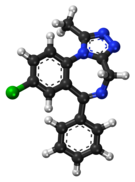
Back ألبرازولام Arabic Alprazolam AST آلپرازولام AZB Алпразолам Bulgarian Alprazolam Czech Alprasolam Welsh Alprazolam Danish Alprazolam German Αλπραζολάμη Greek Alprazolamo Esperanto
 | |
 | |
| Clinical data | |
|---|---|
| Pronunciation | /ælˈpræzəlæm/ or /ælˈpreɪzəlæm/ |
| Trade names | Xanax, others |
| AHFS/Drugs.com | Monograph |
| MedlinePlus | a684001 |
| License data |
|
| Pregnancy category | |
| Dependence liability | Moderate[3] |
| Addiction liability | Moderate[3] |
| Routes of administration | Oral |
| Drug class | Benzodiazepine |
| ATC code | |
| Legal status | |
| Legal status |
|
| Pharmacokinetic data | |
| Bioavailability | 80–90% |
| Protein binding | 80% |
| Metabolism | Liver, via cytochrome P450 3A4 |
| Metabolites |
|
| Onset of action | 30~60 minutes[13] |
| Elimination half-life | Full release: 11~13 hours[14] Extended release: 11~16 hours[14] |
| Duration of action | Full release: 6 hours[13] Extended release: 11.3 hours |
| Excretion | Kidney |
| Identifiers | |
| |
| CAS Number | |
| PubChem CID | |
| IUPHAR/BPS | |
| DrugBank | |
| ChemSpider | |
| UNII | |
| KEGG | |
| ChEBI | |
| ChEMBL | |
| CompTox Dashboard (EPA) | |
| ECHA InfoCard | 100.044.849 |
| Chemical and physical data | |
| Formula | C17H13ClN4 |
| Molar mass | 308.77 g·mol−1 |
| 3D model (JSmol) | |
| |
| |
| (verify) | |
Alprazolam, sold under the brand name Xanax and others, is a fast-acting, potent tranquilizer of moderate duration within the triazolobenzodiazepine group of chemicals called benzodiazepines.[15] Alprazolam is most commonly prescribed in the management of anxiety disorders, especially panic disorder and generalized anxiety disorder (GAD).[9] Other uses include the treatment of chemotherapy-induced nausea, together with other treatments.[14] GAD improvement occurs generally within a week.[16][17] Alprazolam is generally taken orally (by mouth).[14]
Common side effects include sleepiness, depression or suppressed emotions, mild to severe decreases in motor skills, hiccups, dulling or declining of cognition as well as alertness or general awareness of one's surroundings or even behavior, dry mouth (mildly), decreased heart rate, suppression (physiological inhibition) of general central nervous system activity (opposite of physiological excitation), impairment of judgment (usually in higher than therapeutic doses), marginal to severe decreases in memory formation, decreased ability to process new information, as well as partial to complete amnesia (anterograde amnesia[18]) depending on dosage.[14] Some of the sedation and tiredness may improve within a few days.[19]
Alprazolam withdrawal may occur if use is suddenly decreased.[14][16]
Alprazolam was invented by Jackson Hester Jr. at the Upjohn Company[20] and patented in 1971 and approved for medical use in the United States in 1981.[14][21] Alprazolam is a Schedule IV controlled substance and is a common drug of abuse.[3][22] It is available as a generic medication.[9] In 2021, it was the 42nd most commonly prescribed medication in the United States, with more than 15 million prescriptions.[23]
- ^ "Alprazolam Use During Pregnancy". Drugs.com. 4 May 2020. Archived from the original on 20 June 2020. Retrieved 8 June 2020.
- ^ "Prescribing medicines in pregnancy database". Therapeutic Goods Administration (TGA). 21 June 2022. Archived from the original on 2 March 2023. Retrieved 17 June 2024.
- ^ a b c Ait-Daoud N, Hamby AS, Sharma S, Blevins D (2018). "A Review of Alprazolam Use, Misuse, and Withdrawal". Journal of Addiction Medicine. 12 (1): 4–10. doi:10.1097/ADM.0000000000000350. PMC 5846112. PMID 28777203.
- ^ "FDA-sourced list of all drugs with black box warnings (Use Download Full Results and View Query links.)". nctr-crs.fda.gov. FDA. Retrieved 22 October 2023.
- ^ "Therapeutic Goods (Poisons Standard—June 2024) Instrument 2024". Federal Register of Legislation. 30 May 2024. Retrieved 17 June 2024.
- ^ "Xanax Product information". Health Canada. 20 April 2023. Retrieved 17 June 2024.
- ^ "Xanax Summary of Product Characteristics (SmPC)". (emc). 28 July 2023. Retrieved 20 November 2023.
- ^ "List of most commonly encountered drugs currently controlled under the misuse of drugs legislation". GOV.UK. 20 October 2016. Archived from the original on 8 December 2019. Retrieved 20 November 2023.
- ^ a b c "Xanax- alprazolam tablet". DailyMed. Archived from the original on 17 January 2021. Retrieved 19 February 2021.
- ^ "Xanax XR- alprazolam tablet, extended release". DailyMed. 12 March 2021. Archived from the original on 17 April 2021. Retrieved 2 June 2022.
- ^ "Xanax XR- alprazolam tablet, extended release". DailyMed. 12 April 2023. Retrieved 17 June 2024.
- ^ https://www.ema.europa.eu/en/documents/psusa/alprazolam-list-nationally-authorised-medicinal-products-psusa00000109202203_en.pdf
- ^ a b Lilley LL, Snyder JS, Collins SR (2016). Pharmacology for Canadian Health Care Practice. Elsevier Health Sciences. p. 329. ISBN 9781771720663. Archived from the original on 10 May 2022. Retrieved 13 September 2020.
- ^ a b c d e f g American Society of Health-System Pharmacists (13 November 2017). "Alprazolam Monograph for Professionals". Drugs.com. Archived from the original on 7 December 2010. Retrieved 25 October 2018.
- ^ Goldberg R (2009). Drugs Across the Spectrum. Cengage Learning. p. 195. ISBN 9781111782009. Archived from the original on 4 June 2020. Retrieved 24 August 2017.
- ^ a b Verster JC, Volkerts ER (2004). "Clinical pharmacology, clinical efficacy, and behavioral toxicity of alprazolam: a review of the literature". CNS Drug Reviews. 10 (1): 45–76. doi:10.1111/j.1527-3458.2004.tb00003.x. PMC 6741717. PMID 14978513.
- ^ Tampi RR, Muralee S, Weder ND, Penland H, eds. (2008). Comprehensive Review of Psychiatry. Philadelphia, PA: Wolters Kluwer/ Lippincott Williams & Wilkins Health. p. 226. ISBN 978-0-7817-7176-4. Archived from the original on 19 March 2017. Retrieved 13 March 2016.
- ^ Chowdhury ZS, Morshed MM, Shahriar M, Bhuiyan MA, Islam SM, Bin Sayeed MS (2016). "The Effect of Chronic Alprazolam Intake on Memory, Attention, and Psychomotor Performance in Healthy Human Male Volunteers". Behavioural Neurology. 2016: 3730940. doi:10.1155/2016/3730940. PMC 4947648. PMID 27462136.
- ^ Pavuluri MN, Janicak PG, Marder SR (2010). Principles and Practice of Psychopharmacotherapy (5th ed.). Philadelphia, PA: Wolters Kluwer Health/ Lippincott Williams & Wilkins. p. 535. ISBN 978-1-60547-565-3. Archived from the original on 17 July 2020. Retrieved 13 March 2016.
- ^ Ainsworth SJ (9 December 2013). "Hester Dies At 80". Chemical & Engineering News. Retrieved 21 April 2024.
- ^ Fischer J, Ganellin CR (2006). Analogue-based Drug Discovery. John Wiley & Sons. p. 536. ISBN 9783527607495. Archived from the original on 28 August 2021. Retrieved 13 September 2020.
- ^ Malamed SF (2009). Sedation: A Guide to Patient Management. Elsevier Health Sciences. p. 105. ISBN 978-0323075961. Archived from the original on 10 May 2022. Retrieved 13 September 2020.
- ^ "Alprazolam - Drug Usage Statistics". ClinCalc. Archived from the original on 12 April 2020. Retrieved 14 January 2024.
© MMXXIII Rich X Search. We shall prevail. All rights reserved. Rich X Search